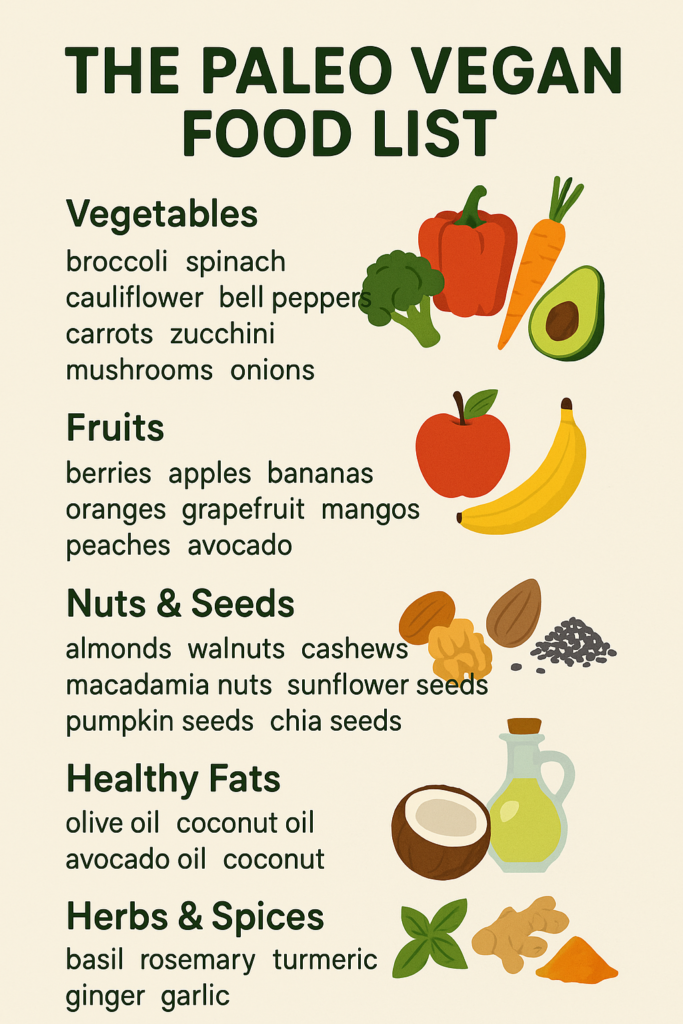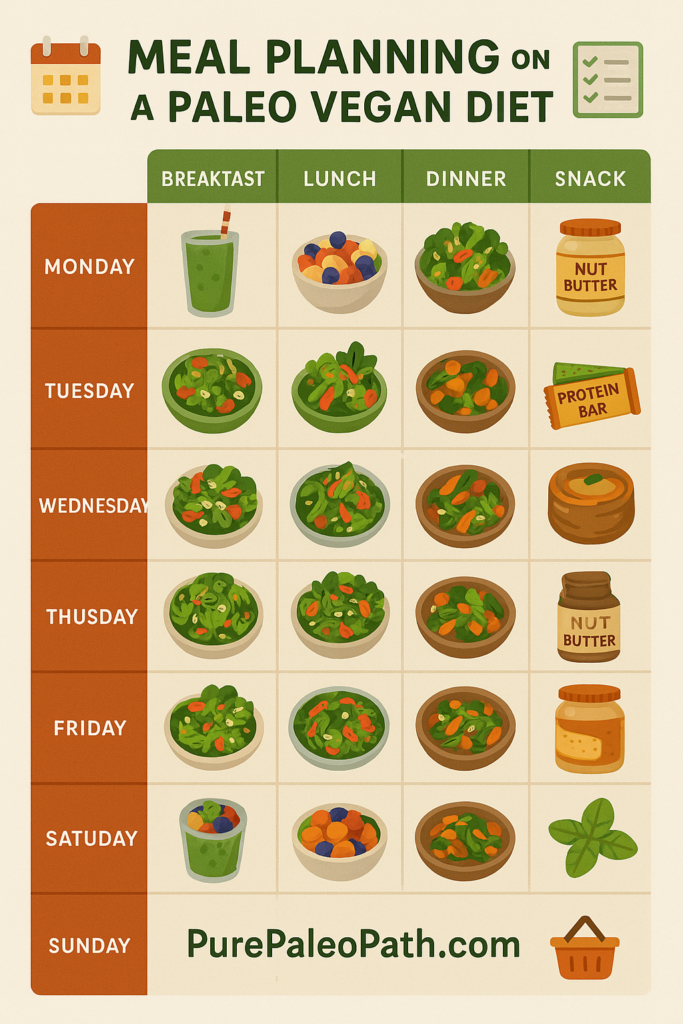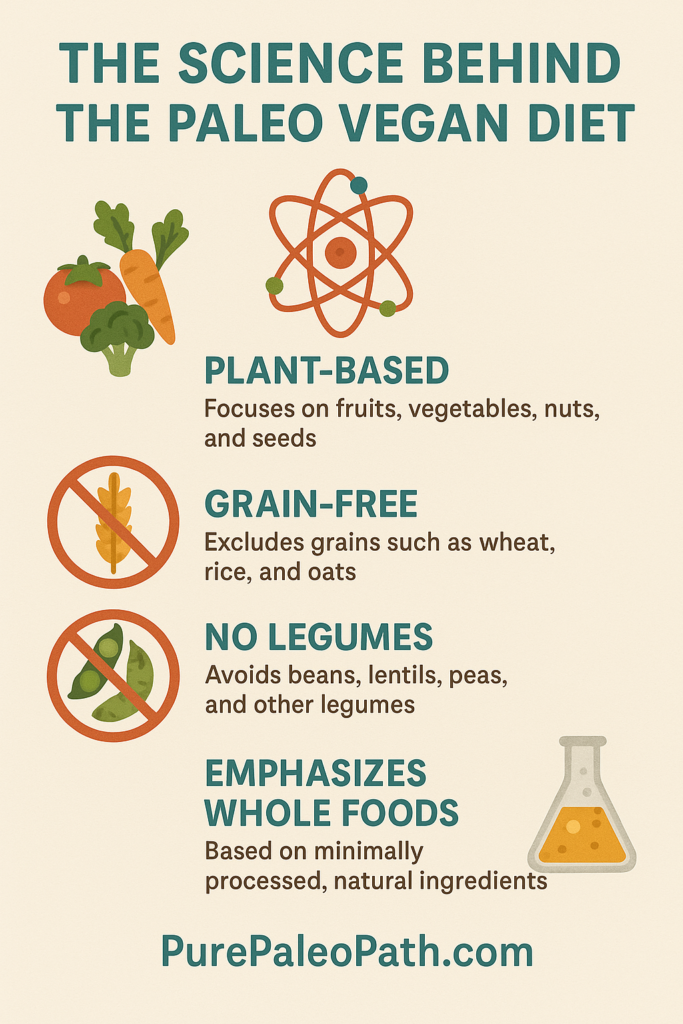Paleo Vegan Diet Food List
The paleo vegan diet combines two popular eating approaches – the paleolithic diet and veganism. This unique fusion aims to harness the benefits of both philosophies while addressing modern health and ethical concerns.
By focusing on whole, unprocessed plant foods that our ancestors might have consumed, the paleo vegan diet offers a fresh perspective on nutrition.
Core Principles of the Paleo Vegan Diet
The paleo vegan diet is built on several key principles:
- Emphasis on whole, unprocessed plant foods
- Exclusion of all animal products
- Avoidance of grains, legumes, and dairy
- Focus on foods available to our Paleolithic ancestors
This approach challenges conventional dietary wisdom by combining ancient eating patterns with contemporary plant-based ethics. The goal is to improve health by consuming foods our bodies are theoretically best adapted to digest and utilize.
The Paleo Vegan Food List

Fruits
- Bare Baked Crunchy Apple Chips
- Apples
- Berries (strawberries, blueberries, raspberries)
- Citrus fruits (oranges, lemons, limes)
- Melons (watermelon, cantaloupe)
- Stone fruits (peaches, plums, apricots)
- Tropical fruits (mangoes, pineapples, papayas)
Vegetables
- Leafy greens (spinach, kale, collard greens)
- Cruciferous vegetables (broccoli, cauliflower, Brussels sprouts)
- Root vegetables (sweet potatoes, carrots, beets)
- Squashes (zucchini, pumpkin, butternut squash)
- Alliums (onions, garlic, leeks)
- Mushrooms
Nuts and Seeds
- Kirkland Signature Organic Raw Almonds
- Walnuts
- Cashews
- Macadamia nuts
- Pumpkin seeds
- Sunflower seeds
- Viva Naturals Organic Chia Seeds
- Flaxseeds
Healthy Fats
Herbs and Spices
- Turmeric
- Ginger
- Cinnamon
- Basil
- Oregano
- Rosemary
- Thyme
Sea Vegetables
- Nori
- Dulse
- Kelp
Fermented Foods
- Sauerkraut
- Kimchi
- Kombucha
Nutritional Considerations
Following a paleo vegan diet needs careful planning to confirm adequate nutrient intake. Here are some key nutrients to focus on:
Protein Plant-based protein sources include:
- Nuts and seeds
- Vegetables (especially leafy greens and broccoli)
- Mushrooms
- Amazing Grass Greens Blend Superfood
Iron Iron-rich foods include:
- Spinach
- Kale
- Pumpkin seeds
- Dried fruits (in moderation)
Vitamin B12 This is challenging to get on a paleo vegan diet. Consider:
- Fortified nutritional yeast
- Garden of Life Primal Defense Ultra Probiotic (check label for B12)
- Supplementation (consult with a healthcare professional)
Omega-3 Fatty Acids Plant-based omega-3s:
- Flaxseeds
- Chia seeds
- Walnuts
- Nordic Naturals Ultimate Omega
Calcium Calcium-rich foods:
- Leafy greens (kale, collard greens)
- Almonds
- Sesame seeds
Meal Planning on a Paleo Vegan Diet

Creating balanced meals requires creativity and planning. Here’s a sample day:
Breakfast
Smoothie bowl with mixed berries, spinach, and Califia Farms Unsweetened Almond Milk. Topped with chopped nuts and Viva Naturals Organic Chia Seeds.
Lunch
Large salad with mixed greens, avocado, and roasted root vegetables. Dress with a tahini-based dressing and a drizzle of Chosen Foods Avocado Oil.
Dinner
Mushroom and vegetable stir-fry cooked in Nutiva Organic Coconut Oil, served with cauliflower “rice”.
Snacks
- Bare Baked Crunchy Apple Chips
- Vegetable crudités with guacamole
- Handful of Kirkland Signature Organic Raw Nuts
Beverages
- Water
- Herbal teas
- Fresh coconut water
Challenges and Solutions
Nutrient Deficiencies
- Eat a variety of whole foods
- Use fortified products (like nutritional yeast)
- Consider supplements
Social Situations
- Plan ahead
- Bring your own dishes
- Review restaurant menus in advance
Avoiding Overreliance on Nuts and Fruits
- Emphasize vegetables
- Add protein-rich seeds (chia, pumpkin, flax)
- Include starchy veggies like sweet potatoes
Adapting the Diet for Different Needs
Athletes and Active Individuals
- Add energy-dense foods like avocados and coconut
- Try UNLEASH’D ORGANIC Organic Sweet Potato Powder
- Fuel pre- and post-workouts
Individuals with Autoimmune Conditions
- Eliminate nightshades
- Limit nuts if digestive issues occur
- Focus on anti-inflammatory foods
Advanced Strategies for Paleo Vegan Success
Meal Prep and Batch Cooking
- Use Prep Naturals Glass Food Storage Containers
- Roast mixed veggies
- Mix seeds and nuts for snacks
Fermentation and Sprouting
- Make sauerkraut or kimchi
- Sprout seeds for salads
Incorporating Superfoods
- Spirulina
- Maca powder
- Terrasoul Superfoods Organic Medjool Dates
- Cacao nibs
Environmental Impact
The paleo vegan diet can:
- Lower carbon footprint
- Reduce water usage
- Support local, organic farming
But be mindful of imported items like exotic fruits and nuts that may have a higher environmental impact.
The Science Behind the Paleo Vegan Diet

While specific research is limited, here’s what we know:
- Plant-based diets lower risk of heart disease and some cancers
- Paleo diets may reduce inflammation and improve blood sugar
- Eliminating processed food supports weight loss and better metabolic health
Transitioning Tips
- Gradually remove non-compliant foods
- Try new recipes and ingredients
- Focus on nutrient-dense options
- Be patient and attentive to your body’s feedback
Common Misconceptions
“It’s too restrictive”
There’s still a wide variety of plant foods to enjoy!
“It’s not nutritionally complete”
With planning and possible supplementation, it can be nutritionally adequate.
“It’s not sustainable”
Many find success with this lifestyle long-term, though it’s not for everyone.
Tools and Resources
- Nutrition tracking apps
- Meal planning tools
- Paleo Vegan Cookbooks like Paleo for Beginners by John Chatham
- Lodge Cast Iron Skillet for paleo cooking
People Also Asked
What is a paleo vegan diet?
A hybrid of paleo and vegan principles, focused on whole, plant-based foods while excluding grains, legumes, and animal products.
Can you get enough protein?
Yes, with careful planning using nuts, seeds, and vegetables.
Are sweet potatoes allowed?
Yes, they are a paleo vegan staple.
How do paleo vegans get B12?
Through fortified foods or supplements.
Is it good for weight loss?
It can be, due to whole food focus and calorie control.
Can you eat fruit?
Yes, fruit is encouraged.
What oils are allowed?
Coconut, olive, and avocado oil.
Is coffee allowed?
While not strictly paleo, many include it in moderation.
How do you get omega-3s?
Flaxseeds, chia seeds, walnuts, and possibly supplements.
Is it good for athletes?
Yes, with adjustments for energy and nutrient needs.
Key Takeaways
Requires meal prep and commitment to sustainability
Combines paleo and vegan principles
Whole, unprocessed plant-based foods
Eliminates animal products, grains, legumes, and dairy
Needs careful nutrient planning
Offers potential health and environmental benefits
